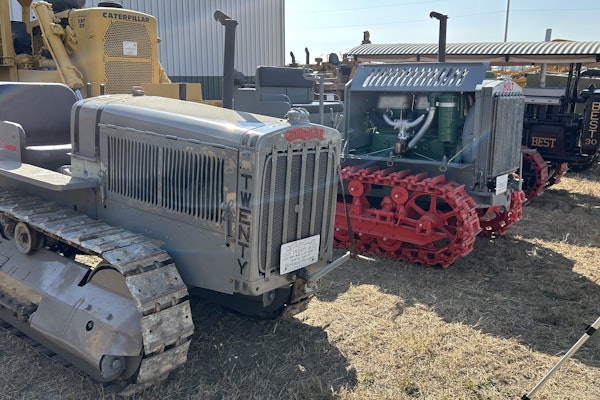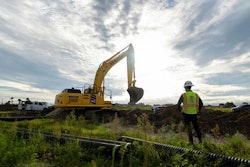 Good teamwork, good friends and an eye for small clues net one of Florida’s most active stolen equipment gangs
Good teamwork, good friends and an eye for small clues net one of Florida’s most active stolen equipment gangs
BY TOM JACKSON
Details make a difference, whether they concern construction contracting or police work. It was two small, separate items that caught the eye of D.T. “Rusty” Russell, a detective working in Florida’s Saint Lucie County Sheriff’s Office, and led to the biggest stolen equipment bust of his 18-year career.
In 1998 St. Lucie County experienced a rash of heavy equipment and tractor trailer thefts. There seemed to be no common thread linking the thefts, but an anonymous tip led Russell and his investigators to a house on the outskirts of town with a large yard hidden from sight behind a fence. Russell didn’t have a warrant to search the premises, but in eyeing the property from the road he noticed a stack of pallets outside. Printed on the pallets was the company name of one of the theft victims.
Bingo.
That was enough to start surveillance
Three weeks later in the middle of the night Russell’s investigators observed a suspect moving a stolen tractor off the property. That led to a warrant, and once inside Russell and his investigators found a treasure trove of stolen goods. “This guy was stealing everything,” Russell says. “His primary interest was heavy equipment, but he was not above stealing your bass boat if he saw a good opportunity.”
A CHANCE ENCOUNTER
At that point, all they had on the suspect (called John, not his real name) was possession of stolen goods. John’s story was that he was just warehousing and moving product for somebody in Miami. The case might have ended there, but in the cache of stolen equipment Russell noticed a purple semi-truck with the name of a Miami company painted on its side.
Two weeks later Russell was driving home late in the evening and saw two trucks with the same color and logo – and no trailers – pull into a truck stop in Fort Pierce. He ran a check on the tags and sure enough, they were stolen.
That bust led them down to Miami and a character Russell calls “Manny,” who turned out to be John’s co-conspirator. But unlike John, Manny quickly spilled the beans.
MAY I TAKE YOUR ORDER PLEASE?
What Russell and his investigators heard from Manny was a story of audacious criminals repeatedly hitting contractors, dealers and other victims whose naiveté made them easy marks.
“These guys were contract thieves,” Russell says. “They stole to order.”
Using a phony offshore company as their cover, they would take requests for a certain type of equipment and then drive around until they found what the customer wanted. “They’d come back and show the buyers Polaroids of what they’d found, give them a price and let the customer pick out the machine they wanted. Then they’d go out the next night and steal it.”
A lot of John’s success was due to his familiarity with the equipment. “He had been in construction his whole life,” Russell says.
STOLEN IN BROAD DAYLIGHT
Russell cites as an example a job at a small construction site where an auto dealership was expanding its facilities. It was a pleasant Saturday afternoon and John drove his truck up to the site, loaded a Deere backhoe onto his lowboy, chained it down and drove off. “The salesmen were outside shooting the breeze and no one asked him a thing,” Russell says. “He knew if he tried it at 4 a.m. it would look suspicious. So the solution was to steal it in plain view and broad daylight.”
Another weak link John exploited was interchangeable construction equipment keys. “If you wanted a certain brand of machine and he didn’t have a key for it, he’d go down to the dealership and say ‘Hey, I lost my keys and I need a few extra.’ He’d pay cash, so it wasn’t traceable. Later on when we did some more searching we found key receipts from all the big dealerships in the area.”
CHALLENGES IN ROUNDING UP EVIDENCE
From the first anonymous tip to the trial took Russell and his fellow investigators nearly two years. Catching a thief was one thing. Building an airtight case was another. While Manny was eager to cooperate, John never admitted anything. “The challenge was to tie everything back to the ring leader, John,” Russell says. That meant months of reviewing equipment theft reports and calling all the victims and witnesses, exhaustively interviewing them and chasing down additional leads for more detailed information.
Russell organized a task force for the case that included four counties, the state Department of Agriculture and the Florida Highway Patrol. Police task forces can be tricky to manage. The different participants all have limited time, budgets and priorities. And elected officials and prosecutors give priority to murders, rapes, robberies and other high-profile crimes. Even though the dollar amounts on equipment thefts are often quite high (there are plenty of backhoes that cost more than a new Porsche), the problem doesn’t elicit much attention from the general public.
WHO YOU KNOW
Russell says the key to making these task forces work is for all the participants to check their egos at the door. Fortunately for Russell’s case, his task force proved to be a model of inter-agency cooperation. A lot of this success Russell attributes to the old, “it’s not what you know, it’s who you know,” principle.
“There are a lot of questions I don’t know the answers to, but I probably know enough people that I can dig around and find the answer,” Russell says. “Having someone you can call on a personal level and ask for a favor makes a big difference.”
With a lot of the suspects and much of the evidence in Miami 100 miles to the south, Russell found it necessary to develop relationships with the authorities there as well. Spending time getting to know Miami’s law enforcement community on a face-to-face level was a key ingredient in the success of the investigations, he says, and produced much better results than impersonal communication through telephone and e-mail.
Toward the end of the investigation, Russell also tapped into the resources of the FBI. “The agent and I had worked together on previous cases, so we already had a pretty good rapport,” Russell says. And while the FBI did not pursue the case as its own, the information its agents provided led to the recovery of an additional $100,000 worth of stolen equipment that had been loaded on a barge for shipping out of the country.
CASE CLOSED
Two years after Russell first spotted the purple trucks, his task force unloaded two thick binders of evidence on the desks of the state prosecutors. Manny cut a deal with the prosecutors and because of his cooperation got 10 years probation. John, the ringleader, refused to confess to anything and got five years’ jail time and 10 years’ probation. In all, five people went to jail.
With Manny’s cooperation investigators were able to recover about $900,000 worth of the $1.3 million in equipment the gang had stolen,” Russell says. “It wasn’t the greatest resolution,” he says, “but to start out with nothing and end up with what we did – and being able to get a lot of the property back – in my mind was a pretty good thing.”
Tough cases to crack
Given the sticker price of most pieces of mobile heavy construction equipment, nearly any theft of yellow iron qualifies as a serious felony. Despite this, the problem generates little visibility or public concern. We asked Capt. Gerald McGough, who runs the investigative division of the Alabama Department of Agriculture and Industries, and his team of investigators to tell us about some of the challenges they and their peers face in this specialized line of police work. Here’s what they said:
• Contractors are sometimes reluctant to report thefts. Given the rise in insurance rates in the past two years, some contractors would just as soon eat the cost of a stolen piece of equipment rather than report it and risk higher premiums.
• Equipment thieves know what they’re doing. Unlike the common criminal, equipment thieves usually don’t act on impulse, but plan their hits. In one example cited by McGough’s investigators, the thieves hired a legitimate trucking company to pick up and deliver the equipment to them. Presented with a bill of lading and DOT haul permits the thieves had obtained legally, the site supervisor assumed the request was legitimate and let the unwitting trucking company deliver one of the contractor’s biggest and most expensive machines straight into the arms of thieves.
• Police don’t know the equipment well. Report a missing 1968 Camero and every cop in this country will be able to spot it from a half mile away. But few law enforcement personnel know the difference between a backhoe and an excavator, a skid steer and a wheel loader.
• Thefts are not immediately reported. When a car is stolen, police find out immediately. When a piece of equipment is stolen, often during the weekend, contractors don’t report the loss until Monday morning or sometimes even later. Confusion over what pieces of equipment belong at what jobsite, or if anybody borrowed a piece of equipment over the weekend for personal use, can delay reporting further.
• The crime sometimes covers a wide geographic area. That means investigations by necessity require regional task forces. Manpower limitations, the difficulty of conducting investigations in remote rural areas and inter-agency communication all present challenges.
• Equipment thieves joining with larger criminal enterprises. McGough says he’s starting to see a convergence between drug crimes and equipment theft, where the money generated by stolen equipment can be used to fund large drug purchases and other criminal enterprises. Larger criminal organizations can provide thieves additional protection and resources that police must combat to break cases and bring successful prosecutions.
• Reluctance to prosecute. In some tight-knit, rural areas authorities may hesitate to throw the book at somebody’s wayward child for crimes like equipment theft. This is especially true when the thief may be related to local politicians or civic officials.














